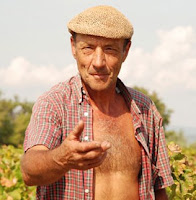 |
| Lionel Lavail and Emmanuel Cazes |
Click here to read what I've said about Cazes and their wines on various occasions over the past six years. The most recent catch-up session with Emmanuel Cazes (vineyard manager & winemaker) and Lionel Lavail (sales director) was at Millésime Bio organic wine show earlier this year, where I had the chance to try some of their 2010 and 2011 vintages. These were my favourite two for entirely different reasons...
Canon du Maréchal 2011 Muscat/Viognier - grapey aromas with exotic touches, apricot vs orange notes; crisp and 'mineral' with light bitter twist, nice and easy style. €6.60 cellar door.
2010 Ego Côtes du Roussillon Villages (still roughly the same Syrah, Grenache and Mourvèdre blend) – attractive dark fruit with savoury edges and towards chocolate notes/texture although it's quite subtle, nice ripe mouthful offset by herby edges, grippy vs rounded mouth-feel. Good stuff, possibly better than previous vintages. €10 cellar door (comparatively much better value than the above).
LATEST vintage VDN released by Cazes tasted here: Rivesaltes ambré 2000 (February 2014).
Canon du Maréchal 2011 Muscat/Viognier - grapey aromas with exotic touches, apricot vs orange notes; crisp and 'mineral' with light bitter twist, nice and easy style. €6.60 cellar door.
2010 Ego Côtes du Roussillon Villages (still roughly the same Syrah, Grenache and Mourvèdre blend) – attractive dark fruit with savoury edges and towards chocolate notes/texture although it's quite subtle, nice ripe mouthful offset by herby edges, grippy vs rounded mouth-feel. Good stuff, possibly better than previous vintages. €10 cellar door (comparatively much better value than the above).
LATEST vintage VDN released by Cazes tasted here: Rivesaltes ambré 2000 (February 2014).






